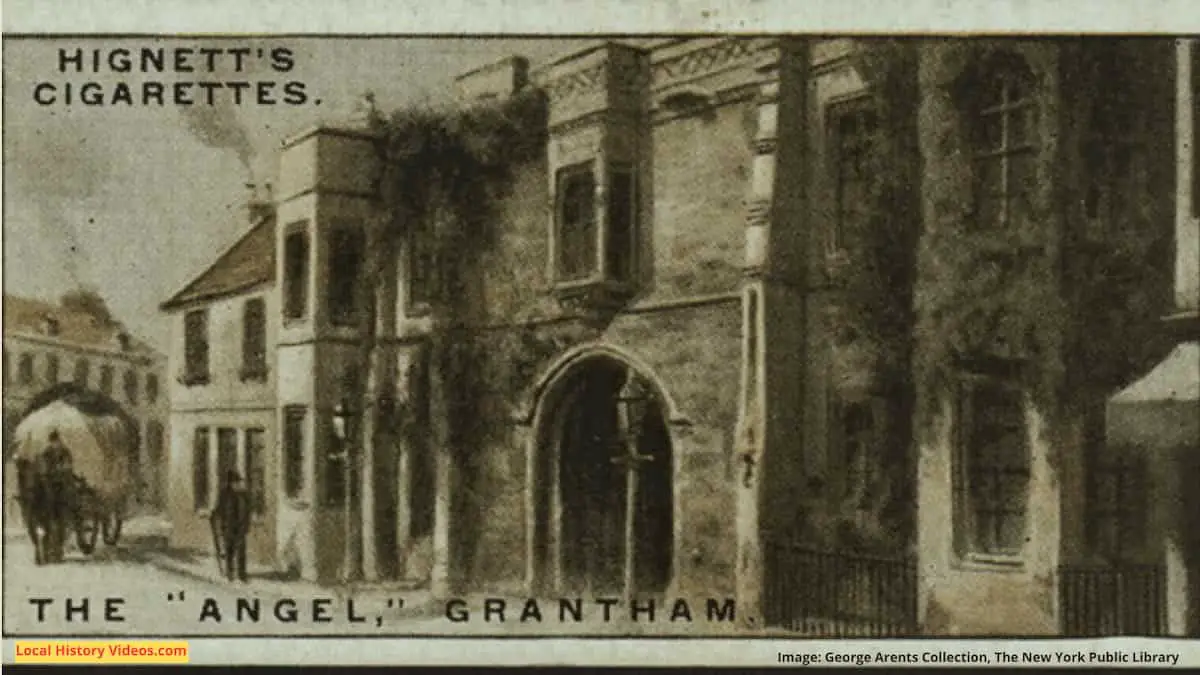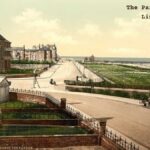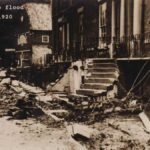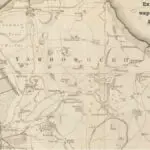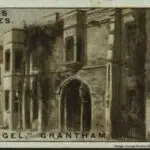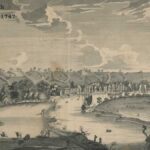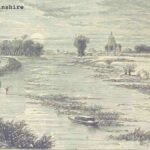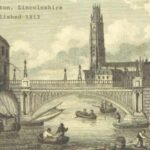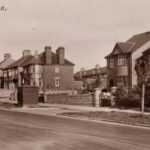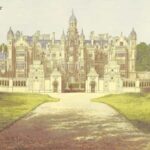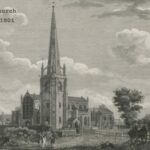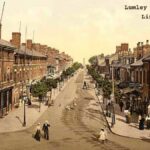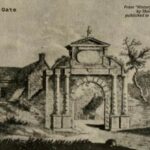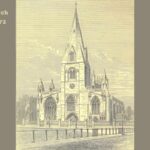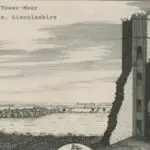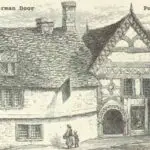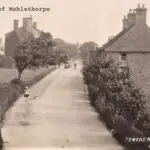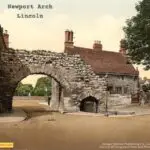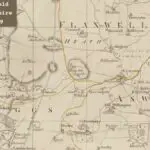Glimpse history through old images of Grantham, Lincolnshire, England.
Dennis Kendall (1945)
During World War II, Dennis Kendall was the Managing Director of British Manufacture and Research Co (BMARC), an armaments firm. From 1942 until 1950 he was also the M.P. for Grantham.
Born in 1903 as William Dennis Kendall, the young lad from Halifax, West Yorkshire, ran away to sea at the age of 14. Helping police raid opium dens along China’s Yangtze River then running a waterfront cabaret in Shanghai, he eventually landed in the US to first work as a steeplejack before moving into car plant production and management.
He came back to Britain in 1938. By the time he was standing as an MP and during his time in post, the MI5 security services had a lot of information about the married man’s string of women friends, extravant spending habits, association with leading right-wing extremists, suspected German links, revelation of wartime production figures while electioneering, currency smuggling, links to the black market, and possible involvement in arms trafficking and smuggling in various countries.
In 1952 he went back to run manufacturing plants in the United States, and died in 1995.
Personality Meet Dennis Kendall (1945) – British Pathé on YouTube
A bit of Grantham history
Extract from “Post office directory of Lincolnshire“, by Kelly’s directories Ltd
Published 1885
Pages 420 – 423
GRANTHAM is a municipal and parliamentary borough, head of a union and county court district, and polling place for the Southern division of the county, market town, in the parts of Kesteven and sake of Grantham, rural deanery of Grantham No. 1, and archdeaconry and diocese of Lincoln.
105 miles from London, 25 south from Lincoln. 21 north from Stamford, 32 south – by – west from Boston. 39 south from Gainsborough, 47 south – west from Horncastle, 14 south – east from Newark and 24 east from Nottingham.
The town was connected with Nottingham by a railway in 1850, and the Great Northern line, affording direct communication between Grantham and London, was opened in 1852.
The corporation is of high antiquity and was originally a popular corporation, elected out of the commonality. In the Patent rolls there are recorded to have been 100 burgesses in the time of the Confessor, and reference is made to an alderman of Grantham in the fourteenth century; the extant charter of 1377, moreover, is but a confirmation of an earlier charter, now lost. These early charters, however, granted special privileges only, and were not charters of incorporation Grantham was first made a corporate town by a charter of Edward IV. dated 1463, and appointing that it should be governed by an alderman, with 12 senior and 12 junior com burgesses; and the first 12 were made justices of the peace by letters patent of Richard III. in 1483: the office of alderman had, however, previously existed, and more anciently still, the town was governed by a bailiff appointed by the lord of the manor; successive sovereigns confirmed and enlarged the privileges thus granted, and in 1664 the charter was renewed, at a cost to the town of £ 170: in 1685 James II. granted a new charter appointing a mayor and six aldermen, but this grant appears to have been subsequently reversed, and the corporation resumed its ancient order.
Under the Municipal Reform Act of 1835, the town is governed by a mayor, four aldermen and 12 councillors, and is divided into east and west wards.
By the Grantham Borough Extension Act, 1879, the Municipal limits were extended and now include Grantham Grange and the adjoining and populous parts of the following townships, viz.: -Harrowby, Manthorpe – cum – Little Gonerby, Somerby and Spittlegate, Houghton and Walton.
The corporation act as the Urban Sanitary Authority. The borough has commission of the peace and separate court of quarter sessions.
The records of the corporation are perfect from the year 1633, and in the crypt of the church still exists the common hutch with three locks in which the archives were anciently kept.
The right to the use of maces as symbols of authority dates from 1464; the existing maces, which are of handsome design, were presented by Brownlow Cust esq, afterwards first Baron Brownlow, on the occasion of his receiving the freedom of the borough in 1766. The statute seal of the corporation, described in the charter of 1632, is double, and bears on one half the arms of the borough, confirmed in 1562: there are other seals for the aldermen and chamberlain, and one for the mayor, given for the use of the aldermen by Arthur Hall, in 1581.
With slight exceptions, the borough has returned two members to Parliament since the year 1467. The parliamentary borough includes, in addition to the municipal borough, all the remaining portions of the above named townships and returns two members to Parliament.
Grantham stands on the river Witham which in early times formed a small lake at this point and was shallow and fordable.
The Ermine Street of the Romans passes within a short distance of the town eastwards.
The town is lighted with gas first used October 30th, 1833, and has been supplied, since 1850, with water from springs which rise in the parishes of Stoke, Stroxton and the Pontons; there is a reservoir at Spittlegate, capable of containing 700,000 gallons of water, and a pumping station at Salter’s ford.
The canal 30 miles long, first opened 1793 under an Act passed in 1792, runs from Grantham to the river Trent and is now the property of the Great Northern Railway Company.
The earliest record of the town is found in the Domesday survey, which shows it to have been royal property anterior to the Conquest, having been held by Editha, queen of Edward the Confessor; and it subsequently belonged to the Empress Matilda.
In 1301, the town was required to furnish King Edward 1. then at Berwick-on-Tweed, with horses and arms for the expedition against the Scots, and in 1318 Grantham and the soke were requisitioned for 15 able – bodied footmen, armed, for the same purpose, a similar number being also demanded in 1324 to serve abroad against the Flemings.
The body of Queen Eleanor, who died at Herdeby, in Nottinghamshire, near Clifton, passed through and rested at Grantham in November, 1290, on its way to London: the cross erected in commemoration of this event was destroyed by the soldiers of the Parliament in or about 1645.
King John was here in August, 1209, and again on February 23rd, 1213, and held his court at the present Angel Inn.
In 1503, Margaret, eldest daughter of Henry VII. who had been betrothed to James IV. of Scotland, remained here one night on her journey into Scotland, and left the town July 10th, 1503, escorted by the aldermen and burgesses.
Charles II was at Grantham in 1663 on his royal progress to receive the crown of Scotland, and accepted from the corporation the gift of a silver cup; on the imposition of the tax called ” ship money, ” the town and soke furnished a sum of £ 200 towards the equipment of a ship of 800 tons required from the county of Lincoln; in 1640 and 1641 the King was again here, and on the breaking out of the civil war the town, being considered a chief post on the north road, was contended for by both parties, and alternately held.
The church of St. Wulfran is a noble and spacious building of stone, in the Norman, Transitional, Early English and Later styles, the foundations also of an earlier Saxon church being still in situ parallel with and just outside the line of the existing arcades.
The present church consists of chancel with aisles, clerestoried nave of six bays, aisles, north and south porches, a chantry chapel on the north side, now used as a vestry, and a noble western tower of the Early Decorated period, rising to a height of 140 feet, and surmounted by a beautiful crocketed spire 145 feet high, making the total height 280 feet; the tower contains a splendid peal of to bells, a clock and set of chimes; the tower, with its magnificent spire, forms the dominant feature of the church, its buttresses of great strength, adorned with niches, support it at the angles and rise into octangular turrets, crowned by crocketed spirelets surmounted by statuettes, three of which represent bishops; the uppermost of the four stages of the tower terminates in a cornice and parapet, and of the others, the second is arcaded and the lowest has a recessed doorway, richly ornamented; the spire may be described as one of the loftiest and most graceful in this country; its surface is relieved by three tiers of lights, in sets of eight, and at the angles by crockets, thickly set; there are also figures at the points of the broaches.
The upper portion of the spire was severely injured by a storm in 1661, and again by lightning in 1797: the spire, damaged by lightning in 1882, was taken down 16 feet and rebuilt to its original height and surmounted with a handsome finial of stone in place of the old copper ball, at a cost of 400, raised by subscription: a new lightning conductor weighing 3 1/2 cwt. has also been fixed.
On the south side the principal features are the porch, which has a battlemented parapet, and an octangular turret staircase, with spirelet, and the picturesque turret which formerly gave access to the rood loft, which has an embattled parapet and tall crocketed spire – like roof; the east elevation exhibits three gables separated from each other and flanked by embattled turrets; on the north side the character of the elevation though more uniform, it is broken by the chapel of the Holy Trinity, and by the large Decorated north porch with a chamber over it, approached by newel staircases at the angles; the porch seems also to have been used as a chapel and retains a piscina in its east wall; at the junction of the chancel and nave there is an octagonal turret corresponding to that on the south side.
A portion of the nave is Normati and some few Norman fragments of later date have been built into the tower; with the exception of these remains, the earliest part of the present fabric is comprised in the three easternmost bays of the nave, which appear to be of Transitional date, the remaining portion being Early English; to the fourteenth century or Decorated period belong the north wall of the nave aisle, the west ends of both aisles, the tower and spire, and the chapel south of the chancel; this latter, dedicated to St. Mary the Virgin, was built about 1360, by William Gunthorpe, and others, and opens by an arcade into the chancel; three of its original windows, with fine flowing tracery, remain, and there is also a piscina; beneath the chapel are two vaulted crypts of the same date, the vaulting being supported in each case by a central pillar; the easternmost crypt has a stone altar, with an aperture in its front intended to contain relies, possibly those of St. Wulfran, and there is also a piscina and a credence; access is now obtained from the outside: but an entrance from the chancel, constructed during the Perpendicular period, and including a richly ornamented doorway and a flight of stone steps leading down to the crypt, still exists.
A bell cote on the western gable of the south aisle seems to indicate the existence there of a chapel at some former time; there is another on the north porch.
The north aisle of the chancel, called the Corpus Christi aisle, from a chantry founded here in the fourteenth century by John de Orston, in honour of the Holy Trinity, is of Late and poor Perpendicular character, circe 1500, and the chapel beyond it, known as ” Hall’s chapel, ” is of the same date: the latter is now used as a vestry and library for the books given by Dr. Newcome, master of St. John’s College, Cambridge, and Dean of Dorchester, to the Corporation of Grantham, and was transferred to the churchwardens by Earl Brownlow in 1819.
Over the south porch is a small chamber containing the library presented to the church early in the sixteenth century by Francis Trigg, priest, of Welbourn; these volumes are all chained to the desks on which they lie, and include some valuable works of the Fathers and earlier Divines; a small Perpendicular bay window looks into the church.
The font, belonging to the Decorated period, has an octagonal panelled bowl, richly carved with subjects from the Old Testament and figures of the Apostles; there are six stained memorial windows including the east window erected in 1883; of the others, inserted during 1852-75, three are at the west end; the northernmost was presented by the trustees of the late Mr. Charles Clarke.
In the church is an altar – tomb of stone, placed beneath a recessed arch in the wall of the south aisle, and inscribed on the margin of the slab to Richard de Calteby, or Saltby, and Margaret, his wife, 1362; and a flat sepulchral slab bears an inscription to John Saltby, of Gunwarby, 1429; more to the east, on the same wall, is another monument, similar to that of Richard Saltby; in the north aisle is a stone tomb, supporting a black marble slab, inscribed to Francis Malham, of Elslack, a devoted Royalist, 1660, by Jane, his third wife; against the same wall and near to the foregoing is an imposing monument by Cheer, to Sir Dudley Ryder, Lord Chief Justice of the King’s Bench, 1754-6, and an ancestor of the present Earl of Harrowby; in the south aisle is a monument to William Cust, a naval officer killed in an attack on Port Louis, Mar. 8, 1747: a representation in relief of the engagement.
The south porch and library were restored by a private benefactor in 1881. The organ, originally built by Byfield, was improved in 1838, again in 1845 and in 1851. In 1869 it was rebuilt and enlarged and the organ case renewed from designs by the late Sir George Gilbert Scott R.A.: the cost, inclusive of £ 500 for the case, was £ 960: a further sum of £85 was expended upon it in 1878.
The chancel is separated from the nave by a hand some carved oak screen designed by the late Sir G. G. Scott R.A. and erected from a legacy left by Mrs. Ottley, at a cost of 800: it takes the place of a former stone screen, long since destroyed; the pulpit was erected by the relatives of the late Hon. Richard Cust, whose friends also presented the handsome brass eagle lectern; the altar – cloth, of velvet, is beautifully embroidered, and was presented in 1869 by the Honourable Lady Welby – Gregory, the whole having been worked by herself and her sister.
The building was extensively repaired in 1866-7, under the direction of the late Sir George Gilbert Scott A. when the whole of the tools were renewed in oak and covered with lead; the entire cost of repairs since 1840 has amounted to upwards £23,000; the north porch was restored in 1877 as a memorial to the late Sir Glynne Earle Welby – Gregory bart. at a cost of £ 500: two doors, ornamented with fine hammered iron for this porch work, and designed by Sir G. G. Scott, were presented by Sir W. E. Welby – Gregory bart.
There are 1,400 sittings, all of which are free. The register dates from the year 1562, but is imperfect till 1580. The living is a vicarage, tithe rent – charge £ 454 gross yearly value 1,000, including 450 acres of glebe, with residence, and charged with endowments for the rectory of Great Gonerby and the vicarage of Spittlegate; it is in the gift of the Bishop of Lincoln, and held since 1883 by the Rev. William Glaister M. A., B.C.L. of University College, Oxford, and surrogate, who also holds the Campden Lectureship, value 100 yearly, in the gift of the Mercers ‘ Company of London.
The church of St. John the Evangelist, in Spittlegate, erected in 1840-2, is a building of stone in the Early English Laneet style, designed by Salvin, and consists of chancel, nave of four bays, aisles, transepts and a western tower with pinnacles, containing 1 bell: in 1883-4 the edifice was restored and enlarged by the extension of both aisles and the rebuilding of the chancel, the interior being also entirely reseated; the total cost was 2,090, one – fourth of which was defrayed by James Hornsby esq, and the rest by subscription: the organ was erected in 1871 by subscription, at a cost of £ 430: there are sittings for 1,100 persons. The register dates from the year 1842. The living is a vicarage, gross yearly value 418 including 1 acre of glebe, in the gift of the vicar of Grantham. and held since 1879 by the Rev. Clement Elsmere M.A. of Christ Church, Oxford.
St. Saviour’s mission church, Manners street, Little Gonerby, is a small brick building attached to the church of St. Wulfran: it was erected by subscription, and is capable of seating about 120 persons: services are also held at Welby school mission – room, Welby street, and Little Gonerby school chapel, Brownlow street, in connection with the same church, and at the Inner Street school mission church, Spittlegate, in connection with St. John’s church.
The Catholic chapel, dedicated to St. Mary, in North parade, Little Gonerby, was erected by the Rev. Thomas Tempest, in 1832, at a cost of £ 5,000, inclusive of priest’s house and school-room, and will seat 250 persons; in 1876 a side chapel was added.
The Baptist chapel, in Wharf road, was erected in 1863-4, the congregation having previously met since 1859 at a house on St. Peter’s hill: the building will hold 600 persons and cost £520.
The General Baptist chapel, in George street, formerly a corn warehouse, was converted to its present use in 1877, at a cost of £ 40: the congregation, formed in 1876, had previously used the Westgate rooms.
The Calvinist chapel is in Castlegate, and will seat 300.
The Congregational chapel, Avenue road, is a building of stone in the Early English style, erected in 1870, at a cost (inclusive of house and school) of £ 4.500, and will seat 600 persons.
The Primitive Methodist chapel, in Commercial road, Spittlegate, was restored in 1867, at a cost of 300; and again in 1876, at a cost of 600, and will now seat about 650.
The Free Methodist chapel, in Chapel street, Little Gonerby, originally Congregational chapel, was purchased in 1869 for 760, its original cost having been 2,200: it is now (1884) being thoroughly restored at a probable cost of £ 750, and will seat 500 persons.
The Wesleyan Methodist chapel, Finkin street, was erected in 1840 on the site of a smaller one: it is an edifice of the Tuscan order, and cost 5,800, inclusive of 7 vestries and chapel keeper’s house, and will seat 1,000 persons: in 1856 an organ was added at a cost of £400: the chapel was restored in 1868, at a cost of £ 200.
The Wesleyan Methodist chapel, in Bridge End road, Spittlegate, is a building of brick with stone facings in the Early Decorated style, and was erected on a site given by Messrs. Hornsby in 1875, at a cost of £ 1,800, two ministers ‘ houses were also built in Dudley road, at a cost of £ 4,500, the site being the gift of William Hornsby esq., the old houses in Wharf road being then sold for £1,050.
The Wesleyan Reform chapel, Swinegate( originally a theatre), will seat 350 persons: in 1873 the interior was remodelled and reseated and other improvements made; an organ was erected in 1875, at a total cost of £ 400.
The Grammar school was founded in 1528 by Richard Fox, Bishop of Winchester, the favourite minister of King Henry VII. and a native of Ropsley: it was endowed by King Edward VI. in 1553 and possesses a revenue of about £1,100 yearly. The school was reorganised under the Endowed School Act of 1876 and is now under the control of a governing body of 15 members, of whom three viz. The Lord Lieutenant, the Mayor and the Chairman of the Board of Guardians are ex-offico governors, six co – optative, three representative appointed by the Town Council, and three by the Burial Board.
There are six exhibitions, in the form of free tuition for 3 years, two being awarded annually. Six junior exhibitions: three of £ 10 and three of 15 each yearly, for 3 years; two of which are awarded yearly to boys under 15 who have been at the school three years. There are also senior exhibitions, not exceeding £ 50 each; for boys over 16, entitling the holders to a professional education at some university: the number of these is regulated by the state of the funds.
Pupils of this school have also a preference in competition for the Newcome exhibition of 40 yearly at St. John’s College, Cambridge, and to two Lovett exhibitions of £ 50 each at Sidney Sussex College, Cambridge, the latter being restricted to sons of clergymen. There are now 9o boys.
Among the distinguished persons educated at this school may be named, Sir William Cecil in 1532; Sir Henry More in 1624; Sir Isaac Newton in 1654: Colley Cibber in 1682; Dean Newcome in 1710; and the Right Rev. Frederick Barker D D. late Bishop of Sydney.
The school – room and adjoining residence, erected by Bishop Fox, are spacious and convenient and were refitted in 1855, and a large dining room added; two class – rooms were added in 1863.
The Grantham Ladies ‘ College, situated on St. Peter’s hill, was established in 1875 for the purpose of providing the daughters of gentlemen a sound and religious education of the highest order, at moderate terms, upon the principles and in the manner which the experience of the Cheltenham Ladies ‘ College had proved to be successful: the funds for promoting the college were raised in 200 shares of £20 each; The Lord Bishop of the diocese is visitor and Earl Brownlow president.
The Guildhall and Police Station, situated on St. Peter’s hill, and erected in 1869, is a building of brick with stone facings, in a mixed Renaissance style, and is surmounted by a clock turret: on the left of the entrance – hall is the borough surveyor’s office, and on the right is the news – room; to the rear is the sessions – hall and magistrates ‘ retiring – room; the whole of the front storey is devoted to the assembly – room, a fine apartment 60 feet long by 30 feet wide, and in the rear are the council and ante – rooms; the police station, with head constable’s residence, is attached to the building on the south side and is flanked by four cottages for police residences.
Quarter, special and petty sessions( the latter every monday), for the borough are held in the Guildhall; Gilbert George Kennedy esq. is recorder.
The old Town Hall, which formerly stood in High street, was pulled down, and handsome premises, for the Stamford, Spalding and Boston Banking Company erected on the site.
The Exchange Hall, High street, in which the corn market is held every saturday, was erected in 1852, at a cost of about £ 6,000, in 5 shares, and is the property of a Company: its area is 8o by 44, feet: the upper storey is devoted to the use of the Public Literary Institution and Reading Society. In November, 1862, it was injured by fire to the extent of £ 1,000, but was restored the following year.
The Westgate Rooms, 66 feet by 40, were erected in 1852 at a cost of about 6,000, in 10 shares, and became the property of the Exchange Hall Company in 1872. The building has a good front, towards the Market – place and the upper storey is occupied as offices of the Inland Revenue. These large halls are often let for sales, and musical and other entertainments.
The Butter Hall, in the Market – place, erected by the town council in 1872, is a convenient but very plain building, and is under the management of the head constable.
The Temperance Hall, in Wharf road, erected by voluntary contributions, in 1874, at a cost of 800, is let for lectures and meetings, and will hold 400 persons.
The Theatre, in George street, opened May 4th, 1875, is a plain brick building, and will hold about 1,800 persons. It is now let to the Salvation Army.
The Conduit, in the Market – place, is an ancient structure, erected in 1579, and supplied by water from springs in Gonerby conducted to the town by the Grey Friars in 1314; it was granted to the town by Robert Fysher in 1684, and in 1860 was thoroughly restored and utilized as a drinking fountain.
In the centre of the Market – place is an Ancient Cross, believed to have been erected by the Grey Friars; John Manners esq. lord of the manor in 1779, took it down, but was compelled by mandamus to replace it, on the ground that Royal Proclamations were wont to be made from it; the cross is at present without its lofty shaft, but it is now (1884) in course of restoration.
Here are three banks, Messrs. Hardy and Co. a branch of the Stamford, Spalding and Boston Banking Company Limited, and a branch of the Leicestershire Banking Company Limited; there is also a savings bank: two newspapers (the ” Grantham Journal ” and the ” Grantham Times “), a large agricultural implement works (Richard Hornsby and Sons Limited), carriage manufactory, paper and corn mills, breweries, tanneries, many building establishments, and there is a large business in malting.
There are many good inns. The principal are the Angel and Royal, and the George.
The Angel and Royal Hotel, in High street, once belonging to the Knights Templars, is one of the three remaining medieval hostels that exist in England the others being at Fotheringhay and at Glastonbury.
The front of two storeys displays a wide pointed gateway, the heads terminating the hood moulding representing Edward III. and Queen Philippa; over the gateway is a boldly projecting bay, resting on a massive corbel; on either side are buttresses, rising to the parapet, and at each – end of the front are square projecting bays, rising to the full height; the parapet is enriched with a band of quatrefoils.
Many interesting associations are connected with this hostelry, one of the earliest being the holding of his court here by King John on the 23rd of February, 1213, as appears from the Patent Rolls of that reign. On the 19th October, 1483, King Richard III. signed in this house the death warrant of the Duke of Buckingham: the apartment in which his signature is said to have been affixed, called “the King’s Room,” runs the whole length of the frontage in High street, and has a richly designed oriel window.
This hotel, under the bequest of one Michael Solomon made in the early part of the tenth century, is subject to the payment of 40s. a year on Michaelmas day, for a sermon on drunkenness.
H.R. H. the Prince of Wales visited this and the George hotel, February 23rd, 1866. The latter hotel is referred to by Charles Dickens in ” Nicholas Nickleby. ”
The ” Chequers Arms ” is another ancient inn, dating from 1562, and was re-erected 1867.
The market day is on Saturday: and the fairs are the first Tuesday in April, and two following days.
Easter Eve stock fair, a stock and annual pleasure fair, Cherry Fair, July 7th, stock fair; September 5th, new ram fair, also for beasts: October 26th, stock fair; December 17th, fat stock, Mr. Henry Escritt holds a fat stock sale every fair, Monday.
The prisons, in accordance with the ” Prison Act ” of 1877, were closed in 1878, and the prisoners transferred to Lindsey County prison at Lincoln; the old gaol is now used as a tobacco manufactory.
The Guildhall news room was opened in 1861; it is maintained by subscription, and is well supplied with London and provincial newspapers and periodicals.
The Steam Laundry, in the Londonthorpe road, is a spacious and well – appointed group of buildings, with extensive drying and bleaching grounds, and is fitted with modern machinery; it is the property of a Company started in 1878, with a capital of 8,000 in shares of 10 each; and from 40 to 50 hands are employed: the modern system of French dyeing and cleaning has recently been introduced.
The Public Baths, erected in Wharf road in 1854, consist of to private baths and a vapour bath, the water being supplied from a well 24 feet deep. They are the property of the Corporation, but are under private management.
The Grantham Hospital, for in – patients only, is situated on the Manthorpe road about mile north of the town: it is a building of stone in the Gothic style, erected in 1874-5, at a cost of £ 5,000, on a site given by the Right Hon. the Earl Brownlow, who, with other gentlemen of the district, subscribed liberally towards defraying the cost of erection: it was opened by Lady Brownlow in January, 1875: the building contains fifteen beds in the main block and five beds in a separate structure, in addition to which there are four private wards; the inmates have since 1883 been admitted free of charge except in certain specified cases.
The Dispensary, situated in Finkin street, was established in 1849 upon the self-supporting system, and has upwards of 4,000 members: it is managed by a committee of 12 members; William Vincent Hardwick, secretary.
The Friendly and Trade Societies Medical Institution, 4 Swinegate, originated at a meeting of delegates held in Grantham in 1878, and was established in 1879. The committee consists of 27 members from whom a managing committee is selected: there are now (1884) upwards of 1,000 members; John Hancock, secretary.
The Campden lectureship is maintained by a sum of money bequeathed in 1651, by Viscountess Campden, the yearly proceeds to be employed for the endowment of two lectureships, one of which was obtained by the Corporation from the Mercers ‘ Company of London, who were the trustees under Lady Campden’s will.
The interest of Charles Clarke’s charity of £ 500, left in 1790, is applied to the repairs of the parish church.
Langwith’s charity. This charity consists of two sums of £ 750 each, bequeathed to trustees by the wills of the late Lucy and Arabella Langwith, in the year 1857, and invested in £ 3 per Cent. Consols, the income being divisible, as to two – thirds thereof amongst ten poor women, residents of Grantham, Spittlegate and Little Gonerby, and the remaining one – third amongst the widows in Hurst’s Almshouses; the annual income amounts to about 42; the vicar of Grantham for the time being and John Grundy Thompson esq. are the trustees.
Other charities were merged in the new Grammar school scheme in 1876. The most important of these is Curteis ‘ Charity, of 175 per annum, consisting of 151, derived from the rent of six houses in Curteis ‘ place, and 24 from land in Spittlegate.
Thomas Hurst D.D. by his will, dated 20th November, 1671, gave certain almshouses adjoining the west end of the churchyard of St. Wulfran, for the residence of eight poor widows, rent free.
Francis Trigg and Anthony Acomes ‘ charities the first bequeathed in 1597 and the latter in 1640, were, by a scheme dated the 19th March, 1860, for the regulation, management and application of the income thereof, directed by the High Court of Chancery to be applied in the first place to the repairs of the almshouses called Hurst’s alms houses, and then in paying to the six senior alms persons elected to such almshouses a sum not exceeding 6s. nor less than 35. 6d. per week.
Bradley’s Almshouses, situated in High street, were built in 1875, and endowed from moneys left for that purpose by Elizabeth, widow of Richard Bradley esq. of Granthara, in the year 1874, for six females, aged not less than 63 years, members of the Church of England, and previous residents of the town or of Little Gonerby; each inmate receives 5s. weekly: the principal is vested in the official trustee of charitable funds, in trust to pay the amount of annual income to the vicar and two churchwardens, who have the choice of the inmates.
Dawson’s Almhouses, situated in Brook street, Little Gonerby, were erected in 1862 by the trustees of the charity left by the will of George Dawson in 1662; these are for ten
poor aged persons, each of whom receives 58. weekly; the income amounting to about 235 is derived from two farms, one at Gosberton and the other at Risegate.
Sir Isaac Newton was born at Woolsthorpe, near Grantham, 25th December, 1642, and commenced his education at the Grammar school here: he afterwards proceeded, in 1660, to Trinity College, Cambridge, where, in 1667, he became a fellow, and in 1669, professor of mathematics; in 1671, he was elected a fellow of the Royal Society, in 1672 he published his theory of light; in 1676 his method of duxions; and in 1687 his ” Principia, ” or mathematical system of physics; in 1699 he was made Master of the Mint.
In 1858, to perpetuate his memory a fine bronze statue by Mr. Theed was erected on St. Peter’s Hill, at a cost of £ 1.800; it was inaugurated by Lord Brougham, and stands on the site of one of the crosses erected by Edward I. to the memory of his Queen Eleanor.
Grantham is situated on the Lias formation, the greater part of it being built upon a deep dry bed of gravel and sand.
The sewage is disposed of since 1881, at a sewage farm at Marston, 5 miles north of the town: it is conveyed by gravitation through a two foot sewer having a total fall of 33 feet, the farm has an area of 231 acres, 105 of which are underdrained five feet, and already under irrigation, producing rich crops of roots and vegetables. The effluent water which issues from the main under drain passes clear and inoffensive through a dyke half a mile long, and is discharged into the Witham.
The manor is now held by the Earl of Dysart.
Grantham Castle, granted to Edmund of Langley, Duke of York, fifth son of Edward III. in 1363, stood north – east of the church; no vestiges now exist. Some remains of St. Catherine’s chantry may be seen between the cemetery and the river Witham.
GRANTHAM GRANGE, formerly extra – parochial, is now a parish within the borough, near the Market – place; it contains about 10 acres of land, laid out as gardens, and is the property of the Earl of Dysart, and was without houses or population in 1881; it was anciently possessed by a house of Grey Friars, established here in 1290; but dissolved by Henry VIII. in 1540; no traces of any buildings now exist.
More about Lincolnshire
- Old Images of Lincolnshire, England
- Old Images of Louth, Lincolnshire
- Old Images of Immingham, Lincolnshire
- Old Images of Grantham, Lincolnshire
- Old Images of Gainsborough, Lincolnshire
- Old Images of Crowland, Lincolnshire
- Old Images of Boston, Lincolnshire
- Old Images of Scunthorpe, Lincolnshire
- Old Images of Harlaxton Manor, Lincolnshire
- Old Images of Spalding, Lincolnshire
- Old Images of Skegness, Lincolnshire
- Old Images of Scampton, Lincolnshire
- Old images of Cranwell, Lincolnshire
- Old Images of Sleaford, Lincolnshire
- Old Images of Horncastle, Lincolnshire
- Old Images of Stamford, Lincolnshire
- Old images of Keadby Bridge, Lincolnshire
- Old Images of Mablethorpe, Lincolnshire
- History in Old Images of Lincoln, UK
- Old Images of Ruskington, Lincolnshire

